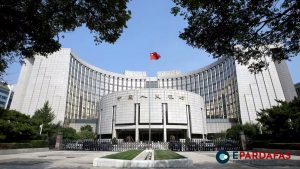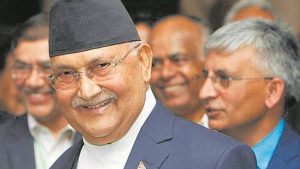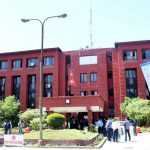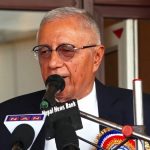For a decade, confusion has surrounded the Belt and Road Initiative (BRI) project in Nepal regarding whether it will be a loan or a grant. Nepal signed the Memorandum of Understanding for the BRI in 2017. However, due to disagreements among political parties, the project has yet to reach the implementation stage.
Even after seven years since signing, the BRI project has not progressed because the ‘BRI Implementation Plan’ remains unfinished. A meeting of the 16th Foreign Secretary-level Diplomatic Consultative Mechanism between Nepal and China, held in Kathmandu on June 11, failed to advance any preparations regarding the BRI implementation plan.
Currently, the ruling Nepali Congress insists that the BRI project in Nepal should proceed only with subsidies, while the CPN-UML favors implementation even if it involves debt. The ruling party itself has not reached an internal agreement on the BRI issue.
While the American cooperation project Millennium Challenge Corporation (MCC) is being implemented in Nepal based on full subsidy, the BRI project from China has not progressed due to a lack of consensus among political parties. Although the US is implementing the MCC on a grant basis, China has not been able to move forward with the BRI despite signing an MoU with Nepal in 2017.
The BRI is essentially a loan-based program. Consequently, China does not appear ready to offer subsidies for this project. China has provided loans to other countries under the BRI project with similar rates and terms. Since there is no possibility of offering loans to Nepal at a lower interest rate than other countries, Chinese officials have already rejected Nepal’s proposal, as early as last June.
In 2017, the MoU for the BRI project was signed. Prime Minister Oli wants to implement the BRI project initiated by China during his tenure. However, the Nepali Congress and other parties maintain that the BRI project cannot be implemented with full debt.
The Nepali Congress believes that the BRI project could be accepted if it were similar to the MCC in terms of US aid, but the project cannot proceed due to the burden of debt. Therefore, the immediate implementation of the BRI project remains uncertain.
During his visit to Beijing in 2016, then-Prime Minister KP Sharma Oli and China committed to developing “big projects” under the BRI framework. China congratulated Nepal on adopting a new constitution, calling it a “historic milestone” in the country’s “political transition.”
Since President Xi Jinping came to power in 2013, China has promoted the One Belt One Road (OBOR), which was renamed BRI in 2015. This initiative aims to connect the world through land and sea routes, covering road networks, infrastructure development, and other areas.
Although Nepal signed the partnership agreement in 2017, confusion persists due to both sides’ inability to agree on project implementation. In 2019, during Prime Minister KP Sharma Oli’s visit to China, Nepal initially sent a list of 35 projects under the BRI. This list was later reduced to nine projects at China’s request. The projects include upgrading the Rasuwagadhi-Kathmandu road, constructing the Kimathanka-Line road, building a road from Dipyal to the Chinese border, the Tokha-Vidur road (with a tunnel), the Galchi-Rasuwagadhi-Kerung 400 KV transmission line, the feasibility study of the Kerung-Kathmandu railway, the Tamor Hydro project (762 KV), the Phukot Karnali Hydro Project (426 KV), and Madan Bhandari University.
Nepal sent a proposal for the BRI project to China at the beginning of 2020, followed by another draft in 2021 when Sher Bahadur Deuba was Prime Minister. However, the Nepali side refused to sign the Chinese draft after finding that it included security and strategic issues.
Another obstacle to BRI implementation in Nepal is the high-interest rate of loans. Despite Nepal’s repeated requests for lower interest rates, China has consistently imposed interest rates exceeding 2 percent, as seen with the Pokhara Airport project. Nepal has been asking China to waive the debt for the airport, but China has refused. Instead, the Chinese ambassador stated that the project was under the BRI framework. The Abuse of Authority Investigation Commission is currently investigating issues of poor quality, commissions, and corruption at the airport, where commercial flights are not possible.
China was once considered a good neighbor to Nepal, practicing “polite and calm” diplomacy. However, since 2014, China has increased geopolitical pressure on Nepal, including for the BRI project. Without agreement among Nepal’s political parties, BRI implementation is unlikely. Nepal already has about 24 billion in debt, with 19 percent of the annual budget spent on interest payments. In such a situation, Nepal cannot take on more expensive external loans.
On May 12, 2017, the BRI framework agreement was signed under the leadership of Pushpa Kamal Dahal, who succeeded Oli as Prime Minister. Nepal formed two committees under the leadership of the Secretary of Finance and the Secretary of Foreign Affairs to identify projects under BRI. The committee recommended 35 projects, which were later reduced to nine based on China’s suggestions. The projects proposed for development under BRI included the Kathmandu-Kerung railway, the Rasuwagadhi-Kathmandu road upgrade, the Kimathanka-Hile road, and the Dipyal to South of China road. Other projects included the Tokha-Vidur Road, the Galchi-Rasuwagadhi-Kerung 400 KV Transmission Line, the Tamor Hydropower Project, the Madan Bhandari University of Science and Technology, and the Phukot-Karnali Hydropower Project.
An estimated investment of US$ 10 billion was required for these projects. It took two years for both parties to agree on the project list and establish an office of a commercial adviser in Kathmandu with officials from China’s Ministry of Commerce.
During Chinese President Xi’s visit to Nepal in 2019, a joint communiqué put all finalized projects, including dry ports, roads, railways, aviation, and communication, under the Trans Himalayan Multi-Dimensional Connectivity Network. According to China, this aimed to advance Nepal’s development agenda, transition from a ‘less developed country’ status, and achieve the Sustainable Development Goals (SDGs) of 2030.
In July 2019, then Chinese Foreign Minister Wang Yi agreed to joint efforts with Nepal to promote connectivity networks within the BRI framework.
The UML-Maoist alliance government handed over two hydropower projects, “Phukot Karnali” and “Tamor,” to Indian companies. During his visit to India in June 2023, Oli criticized the Prachanda-led government for awarding these projects to India at the expense of Nepal. As a result, the nine projects under BRI have now been reduced to seven.














Comments